The Incomplete Wolverine – 1992
Part 1: Origin to Origin II | Part 2: 1907 to 1914
Part 3: 1914 to 1939 | Part 4: World War II
Part 5: The postwar era | Part 6: Team X
Part 7: Post Team X | Part 8: Weapon X
Part 9: Department H | Part 10: The Silver Age
1974-1975 | 1976 | 1977 | 1978 | 1979
1980 | 1981 | 1982 | 1983 | 1984 | 1985
1986 | 1987 | 1988 | 1989 | 1990 | 1991
We’re deep into mythos-building at this point in the 90s, with Wolverine investigating his memory implants and following up on the events of 1991’s “Weapon X” origin story. We’re also deep into the glut of 1992/3, which results in a rather busy year for inconsequential guest appearances. But we kick off the year with a story that does matter.
 WOLVERINE vol 2 #50
WOLVERINE vol 2 #50
“Shiva Scenario, part 3”
by Larry Hama, Marc Silvestri, Dan Green & Steve Buccellato
January 1992
Wolverine breaks into the SHIELD Helicarrier (via improbable motorbike stunts) and demands that Nick Fury hand over his security dossier. Fury relents and hands it over – in the form of several boxes of floppy discs, because it’s 1992. The file has nothing about Logan’s personal history, but does have plenty of information about the Weapon X Project, including the whereabouts of Professor Thorton (who now has a cover job in the Department of Agriculture). Wolverine investigates a Weapon X warehouse in Ontario, and the Professor and Hines follow him there – as does Silver Fox, now an agent of HYDRA.
It’s at this point that Wolverine switches to his yellow costume. The story is very clear – Jean spells it out for us – that this is meant to be a sign of Wolverine’s mental regression, tied to the ill-advised exploration of his hidden memories in the preceding issues. But he’ll stick with the yellow costume long after that plotline fades out.
The warehouse turns out to contain abandoned stage sets apparently used to create memory implant scenarios. For some reason, these things have been left sitting there for years, but at least it makes the discovery more visual. Some of them differ from what Wolverine remembers, because Weapon X re-used the same sets on different people. Wolverine encounters Weapon X’s enforcer robot Shiva, and easily defeats it. But Shiva simply activates a replacement body and attacks again, claiming that Wolverine is “first on my list”. Shiva is much tougher the second time around, and tries a psychic attack that exploits Wolverine’s traumatic memory implants. However he summons up the willpower to declare his humanity, and destroys Shiva again.
While all this is going on, Silver Fox kills the Professor, and Hines falls into the hands of the X-Men. In his dying moments, the Professor accidentally moves Shiva on to the next name on the list without having killed Wolverine – and so all of the remaining Shiva bodies march merrily out of the warehouse in search of name number two, which is Sabretooth. Thanks to his regressed persona, Wolverine is completely unfazed, even when the other X-Men point out to him that the other names on the list might be completely innocent. It’s just not his problem.
During this arc, the Professor refers to the cabin-with-Silver-Fox thing as a memory implant. But we establish very soon that the cabin itself was a real place, so either Hama changed his mind, or the Professor simply meant that there were memory implants involving the cabin as a setting. Hama seems to have been trying to retcon away Silver Fox’s fridging at the hands of Sabretooth (from the flashback in issue #10) by revealing it as a memory implant. Unfortunately, issue #10 winds up being Core Mythos, and Silver Fox’s appearance in this arc has never really been explained. Apparently she just survived somehow. (For more on this, see part 2.)
 That awkwardness aside, “Shiva Scenario” is a hugely important arc in Wolverine history, bringing “Weapon X” into mainstream continuity and setting plenty of core elements of the mythology. So much of today’s Wolverine back story comes from this phase of the Hama run.
That awkwardness aside, “Shiva Scenario” is a hugely important arc in Wolverine history, bringing “Weapon X” into mainstream continuity and setting plenty of core elements of the mythology. So much of today’s Wolverine back story comes from this phase of the Hama run.
MARVEL COMICS PRESENTS vol 1 #93-98
“Wild Frontier”
by Tim Truman & Todd Foxx
January to March 1992
Logan goes hiking in the Eastern Rockies, has a garbled memory of fighting the demon Uncegila there decades ago, and eventually finds Uncegila’s skeleton, proving that the story really happened. It’s a framing sequence for an extended flashback which, at the time, was plainly trying to extend Wolverine’s back story into the 19th century; since that contradicts Origin, the story is now read, somewhat awkwardly, as happening in the early 20th.
 MARVEL COMICS PRESENTS vol 1 #99-100
MARVEL COMICS PRESENTS vol 1 #99-100
“Hauntings” / “Dreams of Doom”
#99 by Rob Liefeld, Howard Mackie, Jim Valentino & Bud Larosa
#100 by Howard Mackie, Sam Kieth & Tim Vigil
March to April 1992
A couple of real obscurities here. Issue #99’s story is an 8-pager plotted by Rob Liefeld, who was on his way to Image by this point. Presumably that’s why other creators wound up finishing it off. The Liefeld story is just Nightmare haunting Wolverine’s dreams. Marvel wound up using it as a lead-in to issue #100, in which Dr Doom tries to enlist Wolverine and Ghost Rider in a scheme to destroy Nightmare (which doesn’t work, obviously).
X-MEN: ODD MEN OUT #1
One-shot
by Roger Stern, Dave Cockrum, Joe Rubinstein & Andrew Crossley
July 2008
Wolverine, Cyclops and the Beast keep watch when Professor X drops in to visit the X-Men’s Silver Age FBI liaison, Fred Duncan. Little more than a cameo.
 WOLVERINE: BLACK, WHITE & BLOOD #2
WOLVERINE: BLACK, WHITE & BLOOD #2
“Unfinished Business”
by Vita Ayala, Greg Land, Jay Leisten & Frank D’Armata
December 2020
When scientist Doctor Price claims to have a breakthrough cure for the X-gene, Wolverine save him from Sabretooth , then advises him to find a new field of research. This is just a generic story aside from the book’s spot-colouring gimmick – the main limitations are that Wolverine’s in his yellow costume, he has adamantium claws, Sabretooth is active as a mercenary, and Professor X is running the X-Men. So this slot is as good as any.
X-MEN vol 2 #4-7
“The Resurrection and the Flesh” / “Blowback” / “Farther Still” / “Inside… Out!”
#4 by Jim Lee, John Byrne, Scott Williams & Joe Rosas
#5 by Jim Lee, John Byrne, various inkers & Joe Rosas
#6-7 by Jim Lee, Scott Lobdell, Art Thibert & Joe Rosas
January to April 1992
While the post-“Weapon X” exploration of Wolverine’s back story takes place in Larry Hama’s Wolverine issues, this arc sees X-Men pick up on it. It clearly dovetails with Hama’s list of Shiva targets, so things were relatively well co-ordinated on that level at least.
 The villains are an alliance of the Hand, Matsuo Tsurayaba, Dr Cornelius from the “Weapon X” storyline, Fenris, and the debuting Omega Red. Omega Red needs a “carbonadium synthesizer” (or “C-synth”) to keep his death powers under control. But the only known C-synth was hidden away by Wolverine years ago, so the villains kidnap Wolverine and take him to Berlin, where they try to extract the C-synth’s whereabouts from him. So far, clear enough.
The villains are an alliance of the Hand, Matsuo Tsurayaba, Dr Cornelius from the “Weapon X” storyline, Fenris, and the debuting Omega Red. Omega Red needs a “carbonadium synthesizer” (or “C-synth”) to keep his death powers under control. But the only known C-synth was hidden away by Wolverine years ago, so the villains kidnap Wolverine and take him to Berlin, where they try to extract the C-synth’s whereabouts from him. So far, clear enough.
Delirious, and hallucinating about old Team X missions, Wolverine is rescued by his Team X teammate Maverick, also making his debut. Maverick is looking for the C-synth too, on behalf of Major Barrington. Wolverine doesn’t recognise Maverick, who plays along rather than risk confusing Wolverine any further. Meanwhile, the villains bring in Sabretooth to recover Wolverine for them. (He shows up with his early-nineties telepath aide Birdy in tow.) Wolverine is recaptured, but the C-synth turns out to have been buried with the late Janet Hollenbeck, who died in the old mission. The X-Men show up, defeat most of the villains and rescue Wolverine. Later, Matsuo and Cornelius try to exhume Janet’s corpse, but Maverick and Wolverine stop them: Maverick shoots Cornelius dead, and Wolverine cuts off Matsuo’s hand before he escapes. (Cornelius will eventually resurface in Death of Wolverine.)
In terms of its impact on continuity, this is an important story: it introduces Team X (not yet named), Maverick and Omega Red, all of which continue to show up regularly to this day. But it’s cluttered and garbled even before you allow for the state of creative confusion on X-Men at the time, with scripter John Byrne being replaced by Scott Lodbell halfway through, and neither seeming entirely what the plot is meant to be. The broad strokes are clear enough, but it’s marred by things like a sequence in issue #5 where Wolverine gets his hands on a cylinder whose significance is never remotely clear.
The story has a footnote placing it after Wolverine #54, but that’s impossible – issue #54 is part of a storyline that runs through without interruption to issue #65, and it includes references to this arc. Fortunately, the story fits quite happily here.
 At the end, Maverick mentions that he’s given Wolverine information “regarding your former comrade”. If you were reading X-Men in isolation, you might have thought this was an important dangler. It isn’t. It’s a lead-in to…
At the end, Maverick mentions that he’s given Wolverine information “regarding your former comrade”. If you were reading X-Men in isolation, you might have thought this was an important dangler. It isn’t. It’s a lead-in to…
MARVEL COMICS PRESENTS vol 1 #101-108
“Male Bonding”
by Scott Lobdell, Gene Colan, Al Williamson & Kelly Corvese
April to August 1992
This is a Nightcrawler story, with Wolverine co-starring for the sake of commercial clout. Nightcrawler is visiting his old circus, Der Jarrmacht, and Wolverine drops by to visit. Under their new leader Jetta, the circus is feuding with a race of monster people, who had also apparently fought Nightcrawler’s homicidal brother Stefan. The heroes sort it all out. Still, it’s got Gene Colan art, which is something.
X-MEN UNLIMITED vol 1 #47
“Bloody ‘Ell”
by Adam Warren, Rick Mays & Guru eFX
July 2003
Over drinks, Psylocke tells Logan about a recent mission where she fought a man who had automatic back-up systems, so that he could keep fighting when he was unconscious. This is a framing device for an evergreen Psylocke story, published during the period when she was supposed to be dead after fighting Vargas in X-Treme X-Men vol 1 #2. Ostensibly, it’s narrator-Wolverine in the present day remembering the time that Psylocke told him this story. It’s cute in its own way, but doesn’t work at all as a Psylocke tribute issue, because she’s very out of character throughout.
 GENERATIONS: WOLVERINE & ALL-NEW WOLVERINE #1
GENERATIONS: WOLVERINE & ALL-NEW WOLVERINE #1
One-shot
by Tom Taylor, Ramon Rosanas & Nolan Woodard
August 2017
Generations was an event in which legacy heroes time-travelled to meet the originals at an earlier point in their histories, for reasons that are neither important nor explained (not in this story, at any rate). In this one, Wolverine teams up with the time-travelling Wolverine (Laura Kinney) – his genetic daughter – to rescue Amiko from the Hand and Sabretooth. Though it’s probably meant to be evergreen, the combination of Wolverine’s costume and a brief appearance by Mariko mean it has to go between Wolverine vol 2 #50-51.
The story actually calls Wolverine’s foster daughter “Akiko”, which was her name in her first published appearance. But I’ll go with the more common one. It’s yet another story where Wolverine is reminded about what a terrible job he’s doing with Amiko, the added resonance being that Laura is so clearly his daughter. As always in these stories, Wolverine vows to do better – and as always, nothing will come of it.
WOLVERINE vol 2 #51-53
“The Crunch Conundrum”
#51 by Larry Hama, Andy Kubert, Dan Green & Steve Buccellato
#52 by Larry Hama, Marc Silvestri, Dan Green & Steve Buccellato
#53 by Larry Hama, Marc Silvestri and various inkers and colourists
February to April 1992
 This arc opens with a Danger Room sequence designed to hammer home the impact of the regression that Wolverine experienced after being confronted with his past: he’s barely breaking a sweat now, and when he’s given a scenario that deliberately provokes him with echoes of his past, he flies into a berserker rage while retaining all his normal fighting skills. The X-Men all find this very disturbing, but Professor X points out that since this is tied to unblocking his memories, perhaps they’re simply seeing Wolverine’s true personality for the first time.
This arc opens with a Danger Room sequence designed to hammer home the impact of the regression that Wolverine experienced after being confronted with his past: he’s barely breaking a sweat now, and when he’s given a scenario that deliberately provokes him with echoes of his past, he flies into a berserker rage while retaining all his normal fighting skills. The X-Men all find this very disturbing, but Professor X points out that since this is tied to unblocking his memories, perhaps they’re simply seeing Wolverine’s true personality for the first time.
So far, so normal. And then…
Wolverine goes out drinking, and Jubilee shadows him when he disappears off to a strange woman’s motel room. It’s actually Mystique, and there’s a distinctly icky implication that they have sex with Mystique impersonating Silver Fox. Mystique wants Wolverine to protect her from someone whose name she refuses to mention, because if anyone says it, “she’ll know”. From Mystique’s description, Wolverine easily works out that it’s Spiral, and dismisses as completely mad the idea that anyone could monitor all of time and space for a common word. Naturally, as soon as he says her name, Spiral appears. (“It’s all in the context, Wolverine. Context and nuance.”)
Spiral then delivers a bizarre monologue, the gist being that something’s wrong with the time stream, and that everyone with time travel powers (including Gateway) is being drawn towards “the Crunch” at the end of the universe. A time vortex then transports Wolverine, Mystique and Spiral to the end of time. Mystique finds the end of time existentially distressing, since it renders everything ultimately meaningless, but the relentlessly practical Wolverine isn’t bothered at all.
After a bit of fighting plasma wraiths, we establish the problem: Mojo is trying to avert the end of the universe. This sounds like quite a good idea, but it’s actually a very bad one, because (apparently) if the Crunch is prevented, then the Big Bang will also be prevented, and the universe will never have existed at all. Mojo insists that he knows this and has plans to survive and rule whatever follows.
In amongst all this, Mojo kidnaps Jubilee; a divergent BDSM plasma wraith version of Jubilee called Abscissa shows up; and Spiral and Mystique retrieve an anti-matter missile from Albert and Elsie-Dee, who had got hold of it in the B-plot. Wolverine then rides the anti-matter missile into the Crunch, which somehow or other resets everything and teleports Wolverine back to New York in the middle of a poker game. Jubilee, meanwhile, appears in Japan with Wolverine’s motorbike, and is promptly arrested.
This is an exceedingly weird and convoluted story which really shouldn’t work. It’s a barrage of non-stop technobabble, paradoxes and increasingly arbitrary plot points. Yet somehow the story gets away with it, because it’s anchored by the idea of Wolverine as a crazy yet down-to-earth pragmatist, utterly unfazed by the lunacy around him. Hama returns to this mode several times, not always successfully; this is the best version.
Issue #54 is a fill-in story which takes place during 1991 continuity. We covered it last time.
 WOLVERINE vol 2 #55-57
WOLVERINE vol 2 #55-57
“Thirty Slashes Over Tokyo” / “We Got Cylla – Can Mothra Be Far Behind?” / “Death in the Family”
by Larry Hama, Marc Silvestri, Dan Green & Steve Buccellato
June and July 1992
Wolverine and Gambit travel to Tokyo to retrieve Jubilee. But before they can find her, they get attacked – first by the Hand, and then by Donald Pierce’s latest cyborg, Cylla Markham. Cylla owes Pierce a favour, but also says she’d do this anyway in order to feel alive. She’s meant to contrast with Wolverine by embracing her nature as a created weapon, and her assigned purpose. Her plan to lure him in is unusual: she ships herself to Japan in a crate, addressed to Logan, and deliberately fails to pay the import duty so that he has to come and see the crate in order to sort things out with Japanese customs.
Wolverine, Gambit and Sunfire drive her away, then head to the Clan Yashida home to ask Mariko for help. Mariko is working on a deal with the Hand, which she hopes will get rid of the Clan’s underworld interests. But Hand leader Matsuo Tsurayaba is more bothered about revenge on Wolverine, so the Hand besiege the building. Mariko is deeply ashamed that, after all this time, she still hasn’t got rid of the Clan’s underworld holdings – the difficulty being to find a way of doing it while protecting the wellbeing of the Clan members, apparently. In keeping with the costume symbolism of issue #50, she offers Wolverine his brown costume to wear while fighting for the honour of her family.
Meanwhile, at Silver Fox’s suggestion, Matsuo sends Reiko to kill Mariko. We saw Reiko in Hama’s first arc. Although she still feels indebted to Wolverine, she doesn’t know about his romance with Mariko, and so doesn’t see a problem with this mission. Silver Fox also leads Cylla to the fight, keeping Wolverine and his allies occupied. Posing as a Hand emissary, Reiko offers Mariko a deal: the Hand will buy the Clan’s unwanted holdings at full price, but Mariko has to cut off a finger in Yakuza tradition. Reiko cuts herself with the knife to prove that it isn’t poisoned, but of course it’s the old “I’ve built up immunity” schtick, and Mariko is fatally poisoned with blowfish toxin. As she dies, Mariko tells Wolverine that she fulfilled her promise to them, and they are married in their hearts. At her request, Wolverine kills her with his claws, sparing her an even more painful death by blowfish toxin. (As for Reiko, she belatedly realises that she’s killed Wolverine’s beloved, and kills herself.)
Jubilee apparently hasn’t heard of Mariko before and unrealistically views her as a rival for Wolverine’s affections, or at least his time. Silver Fox’s motivations are unclear – the obvious reading is that she wants Mariko out of the way due to jealousy, but she’s bitterly aggressive towards Wolverine when they do eventually meet, so presumably this is more about revenge on him.
This is another hugely important story, since although Mariko does eventually return, she’ll be off the board for decades. It’s also a very good story, with all the moving parts being juggled well. Marc Silvestri leaves after this, concluding a run which features some of his best work, when his style was more loose and dynamic.
As for why Mariko is killed off… she had become something of an obstacle. Her storyline with Wolverine hadn’t advanced in years, and she’d become an off-panel love interest who stood in the way of Wolverine forming other relationships. Also, she was an emblem of Wolverine transcending his animal urges, so removing her played into his regression. Surprisingly, Mariko doesn’t get replaced as a love interest – not even by Tyger Tiger, who was obviously being groomed for that role only a few years previously.
This story is retold in flashbacks in Wolverine: Origins #46, but they don’t really add anything. The official timelines also place a flashback from X-Men Unlimited vol 2 #9 here, but that seems to be just the random placement of a single panel of action.
Issues #58-59 are another fill-in story, and they take place later on. We’ll come to them shortly.
 WOLVERINE vol 2 #60
WOLVERINE vol 2 #60
“Counting Coup”
by Larry Hama, Dave Hoover, Keith Williams & Kevin Tinsley
Early September 1992
Logan has been sitting by Mariko’s grave for days, struggling to come to terms with his feelings. Sunfire politely asks Wolverine to leave Japan rather than cause trouble by going for revenge, and when he doesn’t get a favourable answer, he berates Wolverine for acting like a child (well, a “self-pitying wraith of his former self”). After another flashback to Weapon X, which introduces John Wraith into the story, Logan does indeed set off for home – but first he confronts Matsuo Tsurayaba, cuts off his new cybernetic hand, and pledges to return time and again to cut off a new part each time.
This is wildly sadistic stuff which becomes the focus of a rather grotesque back-up story in the Frank Tieri era. It works better in the original context: without Mariko to tether and motivate him, Wolverine sets about avenging her in a way that would have horrified her. At any rate, there are some flashbacks to these later attacks, so we’re going to keep seeing them on the timeline going forwards.
 WOLVERINE vol 2 #61-64
WOLVERINE vol 2 #61-64
“Nightmare Quest!” / “Reunion!” / “Bastions of Glory!” / “What Goes Around…”
#61 by Larry Hama, Mark Texeira & Steve Buccellato
#62-63 by Larry Hama, Mark Texeira & Marie Javins
#64 by Larry Hama, Mark Pacella, Dan Panosian & James Tinsley
September to November 1992
The flight back from Tokyo is diverted by SHIELD. They take Wolverine and Jubilee to meet John Wraith in what seems at first to be a devastated wasteland, but ultimately turns out to be Wraith’s home in South Central Los Angeles. I think the idea was meant to be that they couldn’t see clearly until the dust kicked up by the helicopter had settled, but the art presents it more as if South Central is indistinguishable from a war zone.
Wraith is trying to reassemble Team X, because one of their number, Mastodon, has suddenly reverted to his real age, and is now dying. Wraith has Sabretooth chained up in the basement, and Silver Fox also shows up – in full costume as an officer of HYDRA. Naturally, Wolverine and Sabretooth are both astonished to see her alive. Equally naturally, she loathes Sabretooth, but she has no time for Wolverine either, presumably because of her own memory implants. She also brings along Hines, the last remaining Weapon X scientist.
The other two members of Team X turn out to be crimelord Aldo Ferro, and Maverick, who is currently working as his bodyguard. Ferro claims responsibility for the team’s psi-implants, and inflicts more confusing flashbacks on everyone – before simply scaring Hines to death. Maverick switches sides and joins his teammates in battling Ferro in a Team X reunion. Amidst assorted illusions, Ferro takes his supposedly true cyborg form, Psi-Borg. Ferro also claims here that he only implanted negative memories (since he needed the emotional pain to achieve the desired control) – thus, all Wolverine’s positive memories, including his time with Silver Fox, are genuine. In a confusing sequence, Psi-Borg makes Sabretooth kill Silver Fox for real, then vanishes in a surreal scene where he’s eaten by a tree. (The Sabretooth miniseries confirms that Ferro is covering his escape with an illusion; Silver Fox is genuinely dead, and gets buried next issue.)
This is the start of Mark Texeira’s run as penciller, and he’s a perfect fit for Hama’s tongue-in-cheek machismo, not to mention his surrealist tendencies. Unfortunately, the final issue of is marred by some truly appalling fill-in art.
By the way, although I’m calling them “Team X” for ease of reading, that term isn’t used in this story – they’re simply called “the original Weapon X Project Team”.
 WOLVERINE vol 2 #65
WOLVERINE vol 2 #65
“State of Grace!”
by Larry Hama, Mark Texeira & Marie Javins
January 1993
Despite his reservations, Professor X allows Wolverine to run a Danger Room simulation where he fights Sabretooth. The virtual Sabretooth – supposedly drawing on Wolverine’s subconscious cues, though it would really have to be a mind-reader for the plot to work – accuses Wolverine of suppressing the details of his past so that he can continue to believe that he is a hero. It specifically mentions a “Terry Adams” mission, which is set-up for the next arc. (This approach to Wolverine’s memory gaps will become orthodox in the early 2000s when Origin pushes the idea that Wolverine’s powers heal over traumatic memories.)
When Logan gets into a bar fight, Jean warns him that he can’t take his anger out on strangers like that. Logan explains that he has seen everyone he loved die, and says that while most people can take comfort in their positive memories, he can’t even trust those. Hold on, didn’t Ferro tell us in the previous arc that only the negative memorise were implants? I suppose Ferro’s not trustworthy, but it still reads oddly. The next morning, Nick Fury and John Wraith take Wolverine to the actual cabin for an impromptu funeral. Delighted to learn that their life together was truly real, Logan buries Silver Fox and promises to return every spring.
Technically, Fury and Wraith refuse to tell Wolverine where the cabin is, on national security grounds. But they then let him hike home – which makes it easy for him to work it out. A flashback in issue #66 shows that when he finally gets home after his 200-mile walk and bus trip from Canada, he asks Professor X to remove all his memory blocks so that he can at least see everything that was hidden. Naturally, the Professor flatly refuses.
Wolverine has a break in the action at this point – which is fortunate, because this run of stories began fourteen issues previously. So we double back now to fill in an awful lot of other appearances from 1992 that take place in this gap.
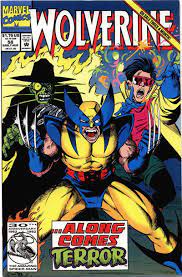 WOLVERINE vol 2 #58-59
WOLVERINE vol 2 #58-59
“Monkeywrenching!”
by D G Chichester, Darick Robertson, Joe Rubinstein & Ariane Lenshoek
August 1992
A fill-in story where Wolverine and Jubilee team up with guest writer D G Chichester’s pet character Terror (who had a solo title at the time) to rescue logging heiress Alice Hoff from an extremist splinter group of the environmentalist Nature Defense League. The splinter group are named in Marvel reference books as Ecotage, though the story itself only uses that term to describe their activities. This has some nice Darick Robertson art, and a cute bit where Wolverine gives himself a buzz cut in order to infiltrate the group, only for it to grow back over the course of the issue. But it can’t seem to make up its mind how seriously it wants to take Ecotage or environmentalism in general.
X-MEN ANNUAL vol 2 #1
“Shattershot, Part 1: The Slaves of Destiny”
by Fabian Nicieza, eight pencillers, six inkers and Joe Rosas
1992
The X-Men’s Blue Team rescue Arize (the Mojoverse scientist who created Longshot and his people) when he appears in Afghanistan, and fend off Mojo’s retrieval team of Gog, Gog N’Magog and Quark. This is the first part of a crossover, but Wolverine doesn’t appear in any of the other chapters.
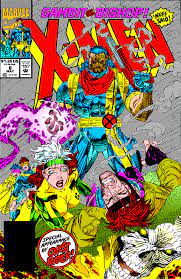 X-MEN vol 2 #8-9 / GHOST RIDER vol 3 #26-27
X-MEN vol 2 #8-9 / GHOST RIDER vol 3 #26-27
X-Men by Jim Lee, Scott Lobdell, Art Thibert & Joe Rosas
Ghost Rider by Howard Mackie, Ron Wagner, Mike Witherby & Gregory Wright
May to July 1992
X-Men #8 kicks off with the storyline about Wolverine’s memories: he’s preoccupied searching for records of his past, and refuses to break off to attend Bishop‘s introduction to the X-Men. The only name he can get out of the computer is “Barrington”, without explanation. Even in 1992, I think that was straining credibility, but let’s be generous and assume it’s a file name or something. (At any rate, it’s obviously referring to Maverick’s boss.) In conversation with Professor X, Logan is troubled that he can feel himself reverting to his pre-X-Men personality, and is deeply upset by the discovery of his many false memories. He agrees that in lieu of certainty about his past, he’ll just have to focus on what he is today.
So much for that. The rest of this is a Gambit arc, which introduces the Thieves and Assassins Guilds of New Orelans. His previously unmentioned wife Bella Donna Boudreaux shows up at the X-Men Mansion, asking him to help restore the peace between the Guilds. The X-Men tag along, and learn that the Brood have been killing members of the Assassins Guild, as well as infecting Ghost Rider. Wolverine takes his usual role in such stories, arguing that Ghost Rider should be killed while he’s still vulnerable. Bella Donna seemingly dies helping to cure the Ghost Rider. Wolverine, Ghost Rider and Gambit then team up against the Brood Queen, and also cross paths with an unspecified Assassin (Bella Donna’s brother Julien Boudreaux). Johnny Blaze, the previous Ghost Rider, shows up at the end, Wolverine kills the Brood Queen, and everyone leaves on good terms.
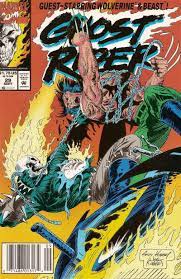 GHOST RIDER vol 3 #29
GHOST RIDER vol 3 #29
“Biting the Hand that Feeds You!”
by Howard Mackie, Andy Kubert, Joe Kubert & Gregory Wright
September 1992
Though he didn’t mention it at the time, Wolverine sensed in Ghost Rider #27 that all was not well with Ghost Rider, so he and Beast drop by to check that he’s definitely Brood-free. He is – his human host Danny Ketch is ill, but Wolverine never gets involved in that. Instead, the two X-Men wind up teaming with Ghost Rider against the Next Wave – Agent-X, Turk and Snare – three freelance security agents who have just quit their jobs to start up their own agency and are… looking for publicity, I guess?
This issue is a petulant swipe at the Image founders, who were quitting Marvel to set up their own business at around this time. It’s not remotely subtle – Agent X obviously represents Jim Lee, Snare is Todd McFarlane complete with “advantageous” equipment, and Turk is a confused moron in a Rob Liefeld-style costume. In the story’s best joke, he blows up his own office wall for no good reason, and his colleagues gently reassure him that it “took a great deal of imagination”. It’s genuinely hard to tell whether the incoherence of the plot and the pointless appearance of Wolverine are meant to be elements of the parody, or whether they’re just standard features of a 1992 issue of Ghost Rider.
DOCTOR STRANGE, SORCERER SUPREME #41
“A Wolverine at the Door”
by Roy Thomas, Jean-Marc Lofficier, Geof Isherwood & George Roussos
May 1992
Possessed by a demon, Wolverine tries to murder Doctor Strange. Once freed, Wolverine insists on tagging along to help fight the Undying Ones. A perfectly serviceable odd-couple team-up, with Wolverine being snarky about Strange’s learned air, and refuses to let Strange take the moral high ground just because he uses “spells of oblivion” instead of claws.
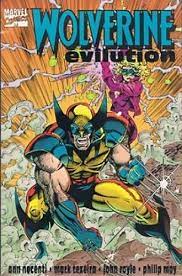 WOLVERINE: EVILUTION
WOLVERINE: EVILUTION
One-shot
by Ann Nocenti, Mark Texeira, John Royle, Philip Moy, Andrew Pepoy & Monica Bennett
September 1994
I’m not sure why the timelines place this quite so far back, though it does take place before its publication date, since Wolverine has his adamantium. Still, this is as good a place as any.
A strange dream draws Wolverine to the town of Prescott, where he’s met by Red Water Fall, an elderly Native American man who was expecting him. Red Water Fall explains that the owners of the local nuclear power plant need to get more land as a buffer zone in order to re-open safely, and his family land is one of the areas they need to buy. Red Water Fall also claims that some sort of magical power is growing in the town, with a new presence in the forest. Meanwhile, Boom-Boom from X-Force is also in town, investigating the local teen luddite cult, the Devos. This all leads to Wolverine preventing the Devos from sacrificing Boom-Boom to the mystic entity using the Spear of Destiny.
Very roughly, the message is meant to be that humanity and technology are in tension; that Wolverine’s adamantium skeleton leaves him torn between the two; and that humans need to control their tools rather than being slaves to them. I think. Ann Nocenti stories tend to be ambitiously bonkers, but this one is just incoherent.
UNCANNY X-MEN ANNUAL #16 (backup)
“Angel of Death”
by Chris Cooper, Jae Lee, Jan Harps & Steve Buccellato
1992
A brief cameo alongside the rest of the X-Men, as Archangel wakes up in hospital at the end of the story.
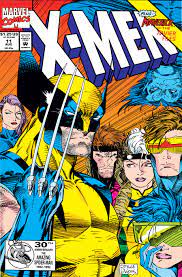 X-MEN vol 2 #10-11
X-MEN vol 2 #10-11
“Where Happy Little Bluebirds Fly…”
by Jim lee, Scott Lobdell, Scott Williams and various
July & August 1992
This is the final Jim Lee story. Mojo captures the X-Men’s Blue Team, alters their personalities, and makes them act out the Wizard of Oz alongside Longshot – Wolverine is the cowardly lion. Naturally, they regain their memories in time to defeat Mojo. Mojo II – The Sequel becomes the new ruler of Mojoworld, and everyone is vaguely concerned that it might not make any difference.
CAPTAIN AMERICA vol 1 #402-407
“Man and Wolf”
by Mark Gruenwald, Rik Levins, Danny Bulanadi & Gina Going
July & August 1992
A murder investigation leads Wolverine to Starkesboro, Massachusetts, which is a populated by a group of werewolves called the Moonchildren. Most are humans transformed by Dredmund Druid and his scientist ally Nightshade, but he has also has a Moon Gem which is drawing real werewolves to town. Wolverine is captured by Druid’s werewolf wrangler Zachary Moonhunter, and Nightshade tries to turn him into a werewolf. Of course, he’s got a healing factor, so it doesn’t work. So Dredmund just hypnotises him instead, and sends him to battle Captain America and Doctor Druid, who are also investigating the town over in the A-plot. Wolverine then spends the second half of the storyline being berserk, until Doctor Druid frees him, and he joins other heroes in defeating Dredmund. Yes, this is the Capwolf arc, where Captain America turns into a werewolf. It’s better than its reputation, to be fair.
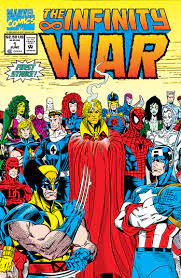 INFINITY WAR #1-6
INFINITY WAR #1-6
6-issue miniseries
By Jim Starlin, Ron Lim, Al Milgrom, Max Scheele & Ian Laughlin
June to November 1992
The X-books didn’t participate in this crossover, but the the X-Men themselves still show up in the group scenes. Adam Warlock’s dark side, the Magus, sends evil doppelgangers after Earth’s heroes. Wolverine’s role is to get attacked in issue #1, expose an impostor in issue #2 thanks to his sense of smell, and then join an expeditionary force which is tricked into fighting the Infinity Watch (Adam Warlock, Drax, Pip the Troll, Gamora and Moondragon). That fight ends when everyone gets hauled off to the finale, in which the Infinity Watch get the Living Tribunal to reactive the Infinity Gauntlet, so that Magus can be defeated. It’s a Warlock & The Infinity Watch arc that would have been better off without all the guest stars, and it spends a lot of time just finding things for them all to do.
Wolverine ticks a few new names off his list as the superheroes of 1992 gather at Four Freedoms Plaza: Moon Knight (Marc Spector), Darkhawk (Christopher Powell), Crystal of the Inhumans, the USAgent (John Walker), the Living Lightning (Miguel Santos), the Black Cat (Felicia Hardy) and Agatha Harkness. It’s also his first meeting with Kyle Gibney as Weapon Omega, and the first time he crosses paths on panel with the Avengers West Coast (though he’s met most of the members) and the new government-sponsored X-Factor (in that case, he’s met all the members).
Wolverine also appears in a slew of tie-ins: Fantastic Four vol 1 #366-370, Marc Spector, Moon Knight #41, Wonder Man vol 2 #13-15, Alpha Flight vol 1 #110-111, New Warriors vol 1 #27, Quasar #38-39, Warlock & The Infinity Watch #8 and Silver Sable & The Wild Pack #5. These are mostly just re-tellings of the events of Infinity War, at least so far as Wolverine’s involvement is concerned. The Alpha Flight issues establish that he notices Weapon Omega (and still doesn’t trust him); the Wonder Man issues add a bizarre subplot in which Wonder Man’s powers are now linked to his emotional state, so he deliberately starts an anti-mutant argument with Wolverine in order to keep his powers up.
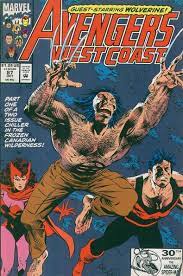 AVENGERS WEST COAST #87-88
AVENGERS WEST COAST #87-88
“Peace Dividend” / “The Second Cold War”
by Roy Thomas, Dann Thomas, David Ross, Tim Dzon & Bob Sharen
October & November 1992
Wolverine teams up with the Avengers West Coast to face the Bogatryi (Syvatogor, Mikula Golubev, Cladimir Volkh and Morning Star), a kind of Russian Fantastic Four who have seized a DEW line station in Canada in an attempt to restart the cold war. It’s a story about unreconstructed Soviets who can’t accept the end of the Soviet Union. It doesn’t need Wolverine, and once again he seems to be here solely to boost sales.
But if you thought Marvel US were a bit too keen on the Wolverine appearances, brace yourselves.
HELL’S ANGEL #1-5
“Hell’s Angel” / “Operation Psycho-Warrior!” / “Subterfuge” / “Hell and High Water” / “Judgement Day”
by Bernadette Jaye, Geoff Senior, Cam Smith & Helen Nally
July to November 1992
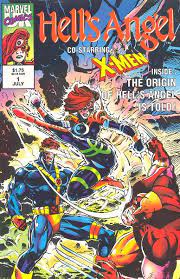 The short-lived Marvel UK imprint included American guest stars in almost every issue as a matter of policy. To make matters worse, early issues were written so that the guest stars could be excised from the British editions, meaning that they had to appear prominently, but could never do anything that was essential to the plot. Unsurprisingly, creators struggled to make this work, and even when the rules were relaxed, the line remained outrageously over-dependent on American guest stars. Some talented people worked on Marvel UK titles – Dan Abnett, Andy Lanning, Liam Sharp, Bryan Hitch, Gary Frank, Carlos Pacheco – but the line was laughably over-extended, and the quality control was at best erratic. We’re going to see a lot of Marvel UK in 1992 and 1993, before the imprint implodes.
The short-lived Marvel UK imprint included American guest stars in almost every issue as a matter of policy. To make matters worse, early issues were written so that the guest stars could be excised from the British editions, meaning that they had to appear prominently, but could never do anything that was essential to the plot. Unsurprisingly, creators struggled to make this work, and even when the rules were relaxed, the line remained outrageously over-dependent on American guest stars. Some talented people worked on Marvel UK titles – Dan Abnett, Andy Lanning, Liam Sharp, Bryan Hitch, Gary Frank, Carlos Pacheco – but the line was laughably over-extended, and the quality control was at best erratic. We’re going to see a lot of Marvel UK in 1992 and 1993, before the imprint implodes.
Deep breath, then. The X-Men investigate a possible new mutant, who turns out to be Hell’s Angel (Shevaun Haldane). Since it’s her book and it’s incredibly unsubtle, the X-Men are hugely impressed with her, and You Should Like Her Too. Hell’s Angel wants to bring down the Mys-Tech Corporation in order to atone for her father’s involvement in their dealings with Mephisto. The X-Men help her out in some battles with Mys-Tech and their Psycho-Warriors, and for reasons we needn’t trouble ourselves with, she’s also helped out by four spirits seemingly plucked at random from the Official Handbook Book of the Dead: Nuke and Nighthawk from the Squadron Supreme, Vakume from Salem’s Seven and the original Viper (Jordan Dixon). In issue #5, the X-Men are also sucked into a “matrix-microverse” guarded by the Encoders, who briefly remove everyone’s powers before they escape. Basically, this book treats the X-Men as members of its supporting cast, and drags them into everything.
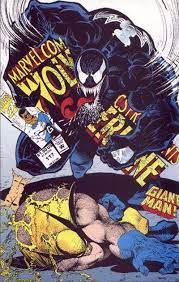 MARVEL COMICS PRESENTS #117-122
MARVEL COMICS PRESENTS #117-122
“Claws and Webs”
by Howard Mackie, Sam Kieth, Dwayne Turner & Mike Thomas
December 1992 to February 1993
Nightmare pits Wolverine against Venom (Eddie Brock) in an attempt to get his hands on Professor X, but the antiheroes team up with Professor X to defeat him. Wolverine recognises Venom immediately, so perhaps there’s a first meeting between the two that remains untold. As for this… well, it’s got some lovely art from Sam Kieth, but the plot is really too straightforward to give him much to work with.
WARHEADS #8-9
“The Dream Trap”
by Nick Vince, Simon Coleby, Rod Ramos & David Leach
January & February 1993
More Marvel UK. The titular group of Mys-Tech Warheads mercenaries – Colonel Liger, Stacy Arnheim, Gregory O’Sullivan, Leona McBride, Che, Misha Bushida and Perez – try to teleport home from a mission, and wind up stuck in Wolverine’s dreams. By a happy coincidence, Wolverine and Psylocke are engaged in a dream sharing exercise for training reasons, so the Warheads get to spend a second issue dealing with Psylocke’s nightmares before she boots them out and sends them on their way. Wolverine doesn’t take very kindly to any of this, and the book is trying to establish an ongoing rivalry between him and the Warheads (he also appeared in issue #1, set back during the Australian era). But Marvel UK won’t last long enough for that to go anywhere.
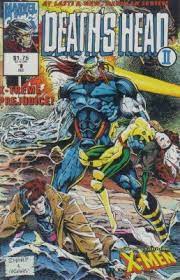 DEATH’S HEAD II vol 2 #1-4
DEATH’S HEAD II vol 2 #1-4
“The Lotus F/X”
by Dan Abnett, Liam Sharp, various inkers & Helen Stone
December 1992 to March 1993
And more Marvel UK. The cyborg Death’s Head II and his sidekick Tuck have come into possession of a cosmic macguffin called the Sapphire Lotus, created by Phaedra; the X-Men detect the energies, investigate, and wind up teaming with DHII against Wrathchilde (Philip Roth). Wolverine gets a bit more prominence than the rest of the team, because the story wants to establish him and DHII as equals, and there’s also a callback to DHII having met an alternate Wolverine in a previous story. This has its moments, if you can overlook the startling female costume designs – Wrathchilde is quite good fun, since he’s an ascended bozo powered up by the Lotus and taking himself far too seriously. Still, it’s rough round the edges.
CODENAME: GENETIX #1-4
4-issue miniseries
by Graham Marks, Andy Lanning, Phil Gascoine and various inkers and colourists
January to May 1993
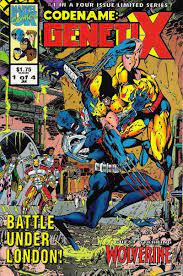 I assume this has been placed here because it claims to take place in summer 1992. Wolverine investigates the murder of an Alberta cop, Lightfoot, at the hands of the Pride, a group of werewolves. The Pride are led by (oh dear) Prime Evil, an escaped creation of MysTech scientist Oonagh Mullarkey who wants revenge on her. Wolverine winds up teaming with her current creations the Genetix – Base (Hiro Sokuto), Ridge, Stinger (Blodwyn Reese), Shift (Clifton Joseph) and Vesper (Raani Jatwinder) – to defeat him.
I assume this has been placed here because it claims to take place in summer 1992. Wolverine investigates the murder of an Alberta cop, Lightfoot, at the hands of the Pride, a group of werewolves. The Pride are led by (oh dear) Prime Evil, an escaped creation of MysTech scientist Oonagh Mullarkey who wants revenge on her. Wolverine winds up teaming with her current creations the Genetix – Base (Hiro Sokuto), Ridge, Stinger (Blodwyn Reese), Shift (Clifton Joseph) and Vesper (Raani Jatwinder) – to defeat him.
This story at least has a sensible reason for using Wolverine as a guest star: the Genetix all have constructed personalities and false memories which they only learn about during the story, plus they’re a bunch of hopeless rookies who need someone with experience to point them in the right direction. Even so, its pretty bland, and reads much like a toy pack-in comic.
X-MEN vol 2 #12-13
“Broken Mirrors” / “Hazardous Territory”
by Fabian Nicieza, Art Thibert, Joe Rosas & Marie Javins
September & October 1992
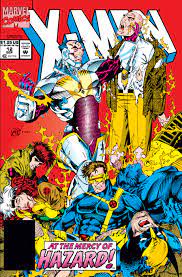 Wolverine discovers a secret file which has been sent to Professor X regarding the activities of the Professor’s late father Brian; it suggests that his nuclear research job at Alamagordo was actually an elaborate cover for government studies in genetic mutation. (This is a storyline which Fabian Nicieza eventually returns to in Gambit.) Soon after, the funeral of Brian’s ex-colleague Alexander Ryking is attacked by the deceased’s mentally ill son Hazard (Carter Ryking), who kidnaps Professor X and takes him to Alamagordo. Government liaison Valerie Cooper alerts the X-Men, who head there to rescue him. Wolverine is preoccupied with his suspicions that Brian was involved in a conspiracy that might have something to do with his own past, and does some general ranting about his fears that his identity is a lie; Rogue has to calm him down so that he can participate sensibly in the mission. The X-Men defeat Hazard, and Wolverine grudgingly accepts that even if there was a conspiracy at Alamagordo, there won’t be any evidence of it now. As the X-Men leave, they fail to notice a report signed by Brian Xavier, Alexander Ryking and Kurt Marko evaluting the Shiva robot from Hama’s Wolverine stories.
Wolverine discovers a secret file which has been sent to Professor X regarding the activities of the Professor’s late father Brian; it suggests that his nuclear research job at Alamagordo was actually an elaborate cover for government studies in genetic mutation. (This is a storyline which Fabian Nicieza eventually returns to in Gambit.) Soon after, the funeral of Brian’s ex-colleague Alexander Ryking is attacked by the deceased’s mentally ill son Hazard (Carter Ryking), who kidnaps Professor X and takes him to Alamagordo. Government liaison Valerie Cooper alerts the X-Men, who head there to rescue him. Wolverine is preoccupied with his suspicions that Brian was involved in a conspiracy that might have something to do with his own past, and does some general ranting about his fears that his identity is a lie; Rogue has to calm him down so that he can participate sensibly in the mission. The X-Men defeat Hazard, and Wolverine grudgingly accepts that even if there was a conspiracy at Alamagordo, there won’t be any evidence of it now. As the X-Men leave, they fail to notice a report signed by Brian Xavier, Alexander Ryking and Kurt Marko evaluting the Shiva robot from Hama’s Wolverine stories.
From this point on, the X-Men series stops trying to pursue the storyline of Wolverine’s past, and leaves it up to his solo book.
EXCALIBUR vol 1 #57-58
“For Whom the Bell Trolls!” / “Troll Call”
by Alan Davis, Scott Lobdell, Joe Madureira, Joe Rubinstein & Kevin Tinsley
November & December 1992
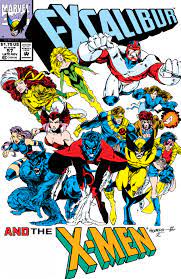 The X-Men team up with Excalibur (well, the ones who haven’t been defeated already) to rescue Alchemy (Tom Jones) from Troll Associates (Phelix, Phough, Phiend, Phit, Phay and Phumm). After Troll Associates are defeated, the various magical creatures aligned with them are sent to live in Wonderland. The story tries to tie in to Hama’s story about Wolverine’s mental regression, but goes seriously over the top with it, presenting him as teetering on the brink of rage throughout. There’s also a bit where Alchemy turns his claws to rubber, and heaven only knows how he’s supposed to have reversed that at the end of the story.
The X-Men team up with Excalibur (well, the ones who haven’t been defeated already) to rescue Alchemy (Tom Jones) from Troll Associates (Phelix, Phough, Phiend, Phit, Phay and Phumm). After Troll Associates are defeated, the various magical creatures aligned with them are sent to live in Wonderland. The story tries to tie in to Hama’s story about Wolverine’s mental regression, but goes seriously over the top with it, presenting him as teetering on the brink of rage throughout. There’s also a bit where Alchemy turns his claws to rubber, and heaven only knows how he’s supposed to have reversed that at the end of the story.
Fortunately, the whole thing is presented as a tale being told to the residents of Wonderland by the Knave (from the Crazy Gang), so the sillier aspects can be handwaved away as an unreliable narrator. Even on its own terms, though, this isn’t a great story. Anyway, Wolverine meets Excalibur members Feron and Cerise here.
Next time, 1993 – and Magneto finally figures out what magnets can do to metal skeletons.

[…] Next time, it’s time to meet Team X. […]
The Ghost Rider #29 story sounds like it could be genuinely funny…until you realize it was written by Howard Mackie, and that he has no room to talk.
Plus, “Biting the Hand that Feeds” as the story title is as unsubtle as one could expect from Mackie (not to mention sounding like a company tool).
The Evilution one-shot was obviously riddled with editorial interference.
I have read that Boom Boom’s role was supposed to be Jubilee, but that Jubilee was unavailable to use for some reason.
The ending seems to have been rewritten by an editor which muddles any point Nocenti was trying to make.
There seem to be two endings to the story now, with them contradicting each other.
I’d have to say that the incoherence isn’t Nocenti’s fault with this comic.
I hate the early-1990s. I had to write the words “Evilution” and “Boom-Boom” in the same paragraph.
Nightcrawler’s circus should be Jahrmarkt rather than Jarrmacht — though perhaps it’s wrong in the story? And I always had the impression that wasn’t the name of the circus, just a word. Google Translate says that “Jahrmarkt” is German for “fair”.
The “Jarrmacht” spelling comes from the story. Issue #105, to be precise, and it’s repeated in a later recap page.
I wonder where Birdy is on the Krakoan resurrection list?
I seem to recall The Shiva Scenario and the robot itself being renamed halfway through the story because of justified complaints from Hindus? Is this correct?
I don’t believe that to be the case. I think they changed it do that SHIVA was an acronym, if that’s what you are thinking about. Otherwise, not that I remember.
“I wonder where Birdy is on the Krakoan resurrection list?”
Between Larry Bodine and Glowworm and Bulk, I suppose…
And they’ll still all come before Destiny and Blindfold, if Mystique doesn’t burn it all down first.
If I were Krakoa, I’d want Larry Bodine resurrected fairly quickly. He’s a good posterboy for the Krakoan ideology.
Also, forget Glowworm. I want to know where is Mindworm (from Amazing Spider Man).
God, CapWolf. And I loved it.
One of my earliest comics along with Clone Saga stuff, Death of Superman, and Knightfall.
Is it any wonder I have weird taste?
Si: On the cartoon they changed Shiva’s name to Talos. Maybe that’s what you’re thinking of?
Entirely possible, yes.
And now we proceed into the era of X-Men that drove me away from comic books for a full decade. At the time, I was excited for the post-Claremont X-Men, but sensed that the stories were not well developed. To many old stories and characters were unceremoniously exterminated. (Goodbye Hellfire Club). And a confusing array of new characters and concepts were being introduced. (Hello Team X). But I was ready to give it time to settle in.
Then came the X-Odus, and it seemed to get worse since so many new plots and characters went nowhere. In hindsight, those artists had no business as writers, and it would probably have been more of mess if they had stayed.
But even as the stories improved, the art suffered (to my teenage eyes, anyhow). I stuck it out through the Kubert era, but by the time we got to AoA and they brought in Joe Mad, I was through.
With that in mind, reading these recaps makes me sad. I see there were some good stories being told, particularly in the solo book, but those X-Men issues just bring up the nagging sense that it was time to let it go.
That Ghost Rider satire issue, though, sounds like it might be a good antidote. I’m going to see if I can’t dig up an e-copy.
Lord, this is the period in which I *started* reading the franchise… and yes, I remember it was often frustrating, due to the well-chronicled confusion and other problems behind the scenes throughout the 1990s, but for whatever reason (friend group, the lower expectations of youth, the underlying concepts, take your pick) I kept buying.
I did get the *perfect* introduction to X-Men in that I got UNCANNY X-MEN #1 (1963) and X-MEN #1 (1991) bundled together at Walmart. The first book established how things started and the second established how things were going now after years of adventures. Game on. But that was definitely the last favor the X-Office did me for a while…
Given the outsized amount of mental and emotional investment I made into X-Men, you’d think my time as a collector was longer than it was. But a few years ago I looked up the publication dates for the issues that bookended my collecting phase, and realized that the period I was an active collector (as opposed to an occasional reader) was fairly brief, less than six years from the end of 1989 until mid-1995.
I came on board Uncanny during the no-team era with issue #255, and I worked really hard to get up to speed. I decided to jump off when they announced the X-Titles would be “cancelled” for AoA; I was going off to college and wanted to devote my attention and meager resources to girls and weed.
By the time I quit, I had a complete run of Uncanny from #200-320, and owned every other story published in Uncanny either as an original, reprint or trade. (Those Classic X-Men reprints were fantastic; I’m astonished that there weren’t more sustained runs of reprints prior to the internet).
I also collected a complete run of X-Factor #1-110, having come in at issue #46, the entire run of X-Force and X-Men v. 2 from their beginning until AoA. I had a sizable collection of New Mutants and Excalibur, and a lot of non-X-Men Marvel comics.
All told, I probably bought fewer than 1000 comic books in those six years—which only comes out to about 3 a week. But it felt like an all-immersive hobby, and for a long time my self-identity was tied up in being a collector and then former-collector.
Turns out I was just a kid buying comics.
@Nu-D: I started earlier than you and I bailed earlier than you, but my feeling was the same. I couldn’t help feeling a little cheated. I had spent so much time with these characters and storylines, and suddenly I didn’t recognize them anymore.
At the end of the day, I couldn’t bear all the bad writing focused on macho characters. And I couldn’t care less about all of Wolverine’s adventures before he joined the team. “Tough loner who used to do morally questionable things” was enough of an origin for me from day 1.
That kind of writing had already ruined New Mutants for me, and then it infected the main title(s). Time to move on to something more satisfying.
That’s funny, I’d take Kubert and Joe Mad over Lee and company all day every day.
We’re closing in on my proper beginning- X-Men Vol 2 #54.
Onslaught Bay Bay!
I quit reading comics the first time after Claremont left the books, with X-Men #3. It wasn’t particularly related to Claremont leaving, more the timing that I was in high school and felt I was too mature for comic books. Now, here I am over 40 and still reading.
I was losing interest in the Marvel Comics around that time though. I had dropped New Mutants after Liefield came aboard as artist.
I discovered Spawn (shudder) and Sandman though, which made me realize that I wasn’t too old for comics.
I couldn’t stay away though. The X-Men kept calling to me. I wondered what I had missed during my break. I had to hunt down all the X-books I missed.
Turns out…not much. heh
I can’t say I enjoyed the X-titles anymore, but dammit, they were my X-titles.
Then, when I heard about AOA, I decided I’d drop all the superhero comics in order to save money and just buy the Vertigo (or indy) books I enjoyed.
It wasn’t long after AOA that I ended up being pulled back in and I decided that I’d just keep buying Uncanny X-Men, no matter the quality, because eventually I’d miss the characters again and end up on a back-issue binge to catch up.
(Although, to my credit, it was only around 2012 that I finally decided to hunt down the AOA comics.)
Woe, did I regret this decision during Onslaught.
I regretted it even more when Chuck Austen was writing the book.
I’ve finally decided with the disappointment that this Hickman-era ended up truncated that as soon as “Inferno” ends, I am finally giving up on X-comics. It’s time.
When I look back and point to original Claremont, Morrison, House/Powers, and most of Carey as the only time I have truly enjoyed Uncanny X-Men or X-Men; I think it’s best to be done.
You’ll be back!
No one can say they’ve really quit an addiction until they’re six feet under.
People hating the Onslaught stuff always amuses me. Not to say it’s great or anything, but in the grand scheme of superhero comics it’s not anywhere near the bottom of the pile either.
The build-up wasn’t that bad.
The payoff was pretty disappointing because what ended up on the page was so mangled by editorial interference.
A lot of the build up ended up going nowhere…oh, what’s that? You say this sounds familiar with the Hickman era?
Plus, the cynical nature that it ended up as an excuse for Marvel ruining so many of their characters so irredeemably they had to turn them over to the dreaded villains of that Ghost Rider issue.
It’s a crossover that was mostly aimed at kids and it served its purpose well of being mindless entertainment.
I mean, looking back, with stuff like Chuck Austen still to come, it certainly wasn’t the nadir of X-Men storytelling.
Outside of X-books, it couldn’t hold a candle to the sheer unreadability of events like “The Crossing” or Teen Tony Stark, no.
It really wasn’t something I was interested in reading after my Sandman comic though.
My eye for Jim Lee has grown more critical over the years, though I still like a lot of his work. At the same time, the work of both Kubert brothers has grown on me, though those early ‘90’s X-books are not the best.
I still hate Joe Mad’s style.
I always liked that little Psylocke tribute issue with Wolverine and her having a drink. You’re right though that she’s wildly out of character. And also, I do get frustrated when Betsy veers between toff and Laaaahndan in her written accent, dropping the h’s. But I did like the “Bloody ‘ell” payoff at the end… At least then, with Psylocke and Colossus, the deaths felt, well, final!
@Chris V: ‘When I look back and point to original Claremont, Morrison, House/Powers, and most of Carey as the only time I have truly enjoyed Uncanny X-Men or X-Men’
I’ve started actively following the books around 2004 and haven’t stopped since. For the vast majority of that time the main X-Men title (whether that’s X-Men or Uncanny or Extraordinary or whatever at the time) was one of the weaker books of the line. Which is the silver lining to the bloat that overtakes the x-line every couple of years (like right now) – the more background titles there are, the better the chances some of them will be good.
That’s definitely the case and I think that may be a reason why a lot of fans point to Onslaught as being so poor.
Maybe qualitatively it wasn’t objectively worse than much of the early-‘90s main X-Men stories.
There wasn’t a great deal going on in the other X-books to make up for it at that point either.
Generation X was the standout book at that time.
I really enjoyed Ellis’ Excalibur also, but he was finishing up his run by the time of Onslaught too.
John Francis Moore’s run on X-Force became my favourite title soon after, but that was still a few months after Onslaught had ended.
Another one who started reading about this point. And not only that, but started reading via whatever random selection of titles were dumped at a newsagent that was slightly out of my way. Sometimes they had Wolverine. Sometimes they had X-Men. Sometimes they didn’t. Sometimes I didn’t manage to get there at all that month. And I just pieced it all together as best I could.
(I think the Marvel UK reprint book doesn’t exist yet, or if it does it was so far behind it just confused me further.)
[…] • 1992. Wolverine mythos reaches critical mass, a full year before the same would start to happen for The X-Files. Follow the money. […]
The US-sized (dimensions, not page count) reprint book started in ’95 or ’96, I think, and began with Uncanny #300.
Chuck Austen is what got me to break my run of Uncanny issues, which started as a regular buyer in the Kubert on X-Men and Joe Mad on Uncanny period. That’s still my favourite time reading X-comics, art-wise. I guess still being a teenager helped.
[…] Part 1: Origin to Origin II | Part 2: 1907 to 1914 Part 3: 1914 to 1939 | Part 4: World War II Part 5: The postwar era | Part 6: Team X Part 7: Post Team X | Part 8: Weapon X Part 9: Department H | Part 10: The Silver Age 1974-1975 | 1976 | 1977 | 1978 | 1979 1980 | 1981 | 1982 | 1983 | 1984 | 1985 1986 | 1987 | 1988 | 1989 | 1990 | 1991 | 1992 […]
“The story has a footnote placing it after Wolverine #54, but that’s impossible – issue #54 is part of a storyline that runs through without interruption to issue #65…”
Isn’t #54 the out-of-sequence issue that’s a fight with Shatterstar? It should logically take place well before the story…
[…] Part 1: Origin to Origin II | Part 2: 1907 to 1914 Part 3: 1914 to 1939 | Part 4: World War II Part 5: The postwar era | Part 6: Team X Part 7: Post Team X | Part 8: Weapon X Part 9: Department H | Part 10: The Silver Age 1974-1975 | 1976 | 1977 | 1978 | 1979 1980 | 1981 | 1982 | 1983 | 1984 | 1985 1986 | 1987 | 1988 | 1989 | 1990 | 1991 1992 | 1993 […]
[…] | 1979 1980 | 1981 | 1982 | 1983 | 1984 | 1985 1986 | 1987 | 1988 | 1989 | 1990 | 1991 1992 | 1993 | […]